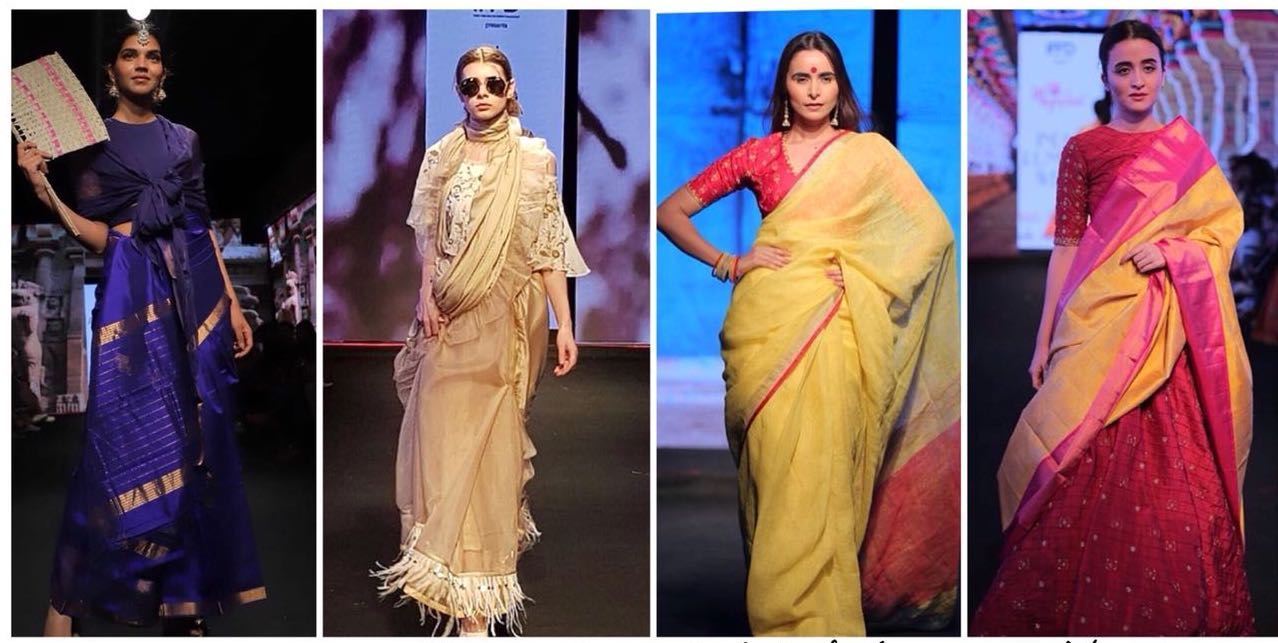I was a stranger to sari (unstitched cloth). My mother is a teacher. Shortage of time and the need for comfort made her wear suit regularly. In high school, we had to wear salwar kameez (long tunic with trousers) along with dupatta (long scarf) as the uniform. At workplace, I had to meet sari. On special occasions, women were told to wear ‘decent Indian outfit’. The outfit was specified. It had to be worn in the Nivi drape with a petticoat and blouse. Western formals and salwar kameez were banned.
For a novice like me, wearing a sari proved to be an ordeal. It was a confusing grammar of pleats and drapes. Getting up very early, sari practice used to occupy a lot of time and energy to attain the minimum required level of presentability. Carrying it during events was a very challenging task. I saved myself from tripping couple of times and the pleats got messy couple of times more. Frequent discussions with girl friends helped me understand that they faced similar challenges with wearing it. They wanted much more variety in their formal clothing. Their choice was guided by comfort and style, not traditions.
These conversations and personal experiences encouraged me to do research on sari. This research made me understand that our ignorance about its history, is having catastrophic effects on ‘women’ and religious minorities. In Sanskrit, sari is a piece of unstitched cloth. It was worn in different ways in different eras in India. During Indus civilization, women generally wore a knee length unstitched cloth.
Vedic age led to women wearing a shawl as an upper garment and a pleated cloth as a lower garment. Gupta age popularized stitched garments in India like the stitched lower garments. In the early Victorian era, the sari was draped around the body, without any blouse and petticoat. It was dominant dress in Bengal and south. Clothing evolved according to the raw material available (e.g. cotton), weather (mostly humid), technology available, caste (breast tax imposed on low-caste women in Kerala) in the region.
Frequent discussions with girl friends helped me understand that they faced similar challenges with wearing a sari. They wanted much more variety in their formal clothing. Their choice was guided by comfort and style, not traditions.
Colonial oppression altered the sari significantly. For the rulers, it was equivalent to nudity. It was considered primitive and immodest. Sari clad women were not allowed to enter clubs. This civilizing mission greatly impacted the Indian elite class. The sari got a colonial makeover. Blouses worn by Parsi and corsets by the British evolved into blouses for the sari. Petticoats were added to be worn as a lower garment below the sari. Gyananda Nandini Debi, the wife of Satyendranath Tagore popularized the sari in urban areas of Bengal by creating the Nivi drape and launching a monthly magazine on them.
Also read: When A Dupatta and A Nose Ring Become Agents Of Patriarchy
With the arrival of the extremists, Nationalist movement also began creating symbols to instill patriotism among the masses. Thus, Mother India was imagined as a woman in saffron sari with rice, cloth, book and rosary in her four hands. She was awakening the countrymen to fight for her as she has suffered cruelly under the colonial rule. This symbol has been used viciously against women and other religious minorities.
In rape cases, women face severe victim blaming (eg. wearing jeans, late night work etc) and exclusion from the community. To reduce crimes, the conservatives try to impose regressive ideas like forcing women to wear saris, not letting them use phones and work outside. This jingoistic nationalism justifies violence against religious minorities like riots, fake terror cases, mob lynching,
In rape cases, Women face severe victim blaming (eg. wearing jeans, late night work etc) and exclusion from the community. To reduce crimes, the conservatives try to impose regressive ideas like forcing women to wear sari, not letting them use phones and work outside.
In the millennial era, the sari is marketed as a trendy and stylish outfit. It can be worn as a skirt, trouser, with denim jackets and aviator glasses. It is sported frequently by celebrities at international events. There is a stark rise in researchers and designers involved in changing perception about saris by launching The Sari Series.
Also read: Sabyasachi Mukherjee And The Practice Of Shaming Women For ‘Culture’
Despite the charms of modernity, we need to be cautious as saris are still used as uniforms to discipline our bodies and dangerously, colonize our minds. We need to explore the theme of clothing and power further with respect to medieval periods and other social classes too. We also need to dig deeper to find out how the sari became a gendered garment in India.
Tanvika is passionate about gender studies, Urdu poetry and Grunge music.
Featured Image Source: Whats Up Life





?????? very funny article
I disagree with the word “gendered garment”. I donot think saree is a gendered garment. It’s male counterpart is dhoti. While dhoti couldn’t evolve as a garment of daily wear for Indian men, saree did..
Also, I love draping saree. It’s something that gives me a sense of self. And it pains me to see that “garment police” is imposing the choice someone could freely exercise of their own will and volition.